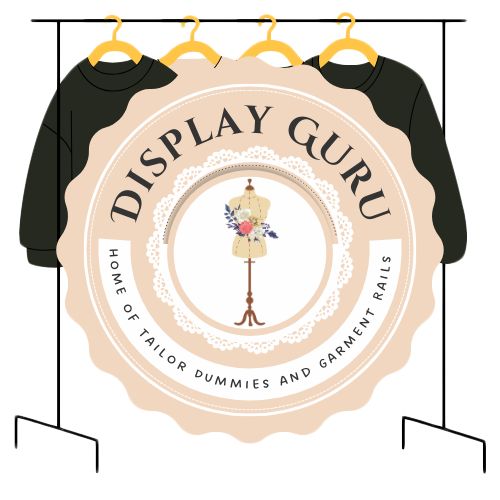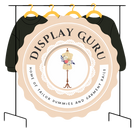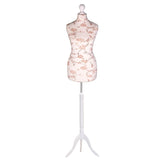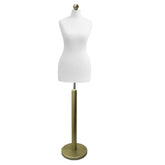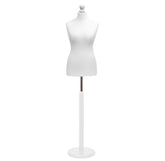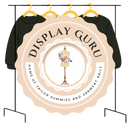Adjustable Dress Forms for Sewing Your Perfect Fit
If you're serious about sewing, an adjustable dress form isn't just a nice-to-have piece of equipment; it's your silent partner. Think of it as a perfect body double, one that lets you create clothes with a precise, professional fit without the endless guesswork of trying to fit garments on yourself. It’s the single tool that can elevate your work from looking 'homemade' to 'expertly tailored'.
Your Essential Partner for Professional Sewing

Imagine having a stand-in of your body, available 24/7 to help you design, drape, and fit your creations. That’s the real magic of an adjustable dress form. It’s far more than a simple accessory; for many of us, it becomes an indispensable sewing companion for achieving that elusive, truly custom fit on every single garment.
I like to think of it as a sculptor's armature—that essential wire frame that provides the structure for the clay. An adjustable dress form for sewing does the same for your fabric. It gives you a three-dimensional canvas to see how material truly drapes, hangs, and wraps around the body, something that's simply impossible to gauge when your pattern pieces are lying flat on a table.
Eliminating Guesswork and Boosting Confidence
The most immediate benefit of a dress form is that it cuts out the frustrating trial and error of self-fitting. We’ve all been there—twisting awkwardly to pin a hem, trying to adjust a shoulder seam you can't see, or struggling to check the fit on your own back. A dress form stands patiently, letting you work from every angle with both hands free. This alone empowers sewers of all skill levels to work with much greater precision.
This shift from guesswork to accuracy is a game-changer, and it's why adjustable dress forms for sewing are a cornerstone of a thriving industry. The UK’s textile and apparel sector, currently valued at roughly £21 billion, is built on tools that enable precision design and tailoring. With projections showing this market could grow to around £32 billion by 2029, it’s clear that professional-grade sewing equipment is more in demand than ever.
A dress form is the bridge between a flat pattern and a finished garment. It’s where your two-dimensional design ideas come to life in three dimensions, revealing how the fabric will truly behave on a body.
A Tool for Every Project
Whether you're making a simple A-line skirt or tackling a complex, tailored jacket, the benefits become obvious almost instantly. A dress form is invaluable for all sorts of projects, helping you apply expert sewing tips and ensuring a flawless fit, even for the most intricate patterns.
To really appreciate its impact, let's break down the core advantages of having an adjustable dress form in your sewing space. This table summarises the key benefits it brings to your workflow.
Core Advantages of an Adjustable Dress Form at a Glance
| Advantage | Description for Sewers |
|---|---|
| Improved Accuracy | Provides a consistent, symmetrical shape, which is critical for creating well-fitting clothes that hang correctly. |
| Enhanced Draping | Allows you to design directly on the form, experimenting with fabric to create new patterns without drafting on paper first. |
| Better Visualisation | You can see your project evolve in 3D, helping you make smarter decisions about silhouette, proportions, and details. |
| Simplified Alterations | Marking hems, placing darts, and adjusting seams becomes a straightforward task instead of a frustrating exercise in contortion. |
These benefits demonstrate how a dress form moves beyond being just a fitting aid to become a central part of the creative process.
Of course, the stability of the form, particularly its base, is a crucial detail to consider for practical use. We have a helpful guide on choosing the right dress form stand to suit your workspace and the types of garments you make.
Ultimately, investing in an adjustable dress form is an investment in your craft. It brings a new level of professionalism and confidence to everything you sew.
Understanding the Anatomy of a Dress Form

To get the most from your new sewing companion, it really helps to know your way around its various parts and how they all work together. Think of it like a musical instrument; each dial for the bust, waist, and hips must be tuned in harmony to create the right silhouette. Getting to grips with these gears and mechanisms is the first step in turning a simple form into your very own body double.
At its heart, an adjustable dress form for sewing is a clever piece of engineering designed to mimic the human torso. The main body is usually made from a series of plastic panels, all wrapped in a thin layer of foam and fabric. This fabric covering is incredibly important—it needs to be pinnable so you can secure fabric directly to the form as you drape and fit.
The real magic, though, is in the adjustment mechanisms. These are the dials and keys that allow the form to expand and contract, letting you recreate a specific set of measurements with precision.
The Core Adjustment Dials
The most obvious features on any adjustable form are the dials. You’ll typically find a set of them for the three key measurement zones: the bust, waist, and hips.
- Bust Dials: Usually found at the front, back, and sides, these let you expand the chest to the right circumference.
- Waist Dials: Positioned at the narrowest part of the torso, these adjust the form to create the correct waistline.
- Hip Dials: Located lower down, these control the expansion across the fullest part of the hips.
Turning these dials—often with a key or simply by hand—gently pushes the internal panels apart, increasing the form’s size. It's crucial to adjust them a little at a time and evenly across the board to keep the shape natural and symmetrical. If you make big changes to one area at once, you can end up with a lopsided form, which completely defeats the purpose.
The secret to a great fit is adjusting all the dials in small, balanced increments. Avoid fully expanding one measurement before starting the others; instead, build up the shape gradually across all points for a more organic and accurate contour.
Beyond the Basic Circumferences
While the bust, waist, and hip are your starting points, a good-quality dress form offers more subtle controls that are vital for a truly personalised fit. These features tackle the vertical dimensions and specific contours of the body.
One of the most important, yet often overlooked, adjustments is the back waist length, sometimes called the torso length. This is usually a small dial or lever near the neck or waist that lets you lengthen or shorten the distance between the neck's base and the waistline. This is so important because a garment made for a long torso will bunch up on someone with a shorter one, and vice versa.
Many forms also include a neck adjustment. This is often a simple dial right at the top that fine-tunes the neck circumference—an essential feature when you’re fitting collared shirts, blouses, or high-necked dresses.
The Foundation: The Stand and Base
Finally, the entire torso needs a solid foundation. The stability of the stand is non-negotiable; a wobbly form isn't just frustrating to work with, it can also be a safety hazard. Most adjustable dress forms for sewing come with one of two main types of stands.
- Tripod Base: Offers fantastic stability on all sorts of floors, including carpets.
- Wheeled Base: Gives you mobility, making it easy to wheel the form around your sewing space.
The stand also allows for height adjustment, letting you set the form to a realistic height that matches your own or your client's. For a deeper dive into taking body measurements, you can learn more about how to capture accurate mannequin measurements in our detailed guide. This knowledge is key to translating real-world dimensions onto your adjustable form.
How to Choose the Right Adjustable Dress Form
Picking out an adjustable dress form is a big step. It’s a real investment in your sewing, so let's get past the generic advice and figure out which model will genuinely work for you. Think of this as your personal roadmap to understanding the features that count, so you can choose a form that becomes a trusted partner in your sewing room.
Now, if you take only one piece of advice, let it be this: the single most important rule for choosing an adjustable dress form for sewing is all about sizing. It’s such a common mistake to buy a form that either matches your measurements perfectly or, even worse, is a bit bigger.
The golden rule? Always size down. You can easily add padding to a smaller form to build it up to your unique shape, but you can't do a thing with a form that’s too big at its smallest setting.
If you find your measurements are sitting between two different sizes, always, always go for the smaller one. You simply cannot shrink a dress form, but you can always add a bit of wadding here and there to perfectly mirror your own body.
Key Features to Compare
Once you’ve got the size sorted, it’s time to look at the features that set different models apart. The right choice for you will often come down to the kind of garments you love to make.
Here's a quick rundown of what to look for:
- Adjustment Mechanism: Most forms use either dials or keys to change their size. Dial-adjusted models are very common and easy to use – you just turn them by hand. Key-adjusted forms give you a bit more control and precision, which some professionals prefer for that extra fine-tuning.
- Pinnable Surface: This is a non-negotiable. Make sure the form has a fully pinnable torso. This means you can stick pins straight into the body, which is absolutely essential for draping fabric, pinning pattern pieces, and marking up alterations. A simple fabric cover stretched over a hard plastic shell just won't cut it for serious sewing.
- Stand Type: The base of your dress form affects both its stability and how easily you can move it. A tripod stand is fantastic for stability, even on carpet, while a wheeled base gives you the freedom to roll your form around your workspace with ease.

As you can see, an adjustable form gives you far better fit accuracy and can seriously cut down your fitting time. For anyone working with different body shapes or creating custom-fit clothing, it’s a much more efficient way to work.
Comparing Adjustable Dress Form Features
To help you decide which type of adjustable dress form best suits your sewing needs and budget, here’s a feature-by-feature comparison.
| Feature | Standard Dress Form | Bifurcated (Leg) Form | Professional Grade Form |
|---|---|---|---|
| Best For | Dresses, skirts, blouses, jackets, general garment making. | Trousers, shorts, swimwear, jumpsuits, and lingerie. | Advanced draping, bespoke tailoring, complex designs. |
| Adjustment | Typically 8-12 dials for bust, waist, and hips. | Includes thigh and inseam adjustments alongside torso dials. | Often features more adjustment points and finer mechanisms. |
| Pinnability | Usually has a pinnable foam-backed nylon cover. | Same pinnable surface as a standard form, but extended. | Heavy-duty, fully pinnable surface designed for constant use. |
| Specialty | The versatile workhorse for most home and hobbyist sewists. | Essential for checking the fit and drape of bifurcated garments. | Built for durability, precision, and a professional workflow. |
| Price Point | Most affordable and widely available option. | A more specialised and therefore pricier investment. | The highest price point, reflecting its robust construction. |
This table should give you a clearer picture of where your needs fit. A standard form is a brilliant all-rounder, but if trousers are your passion, you'll quickly see the value in a bifurcated model.
Do You Need a Form with Legs?
For most of us, a standard torso form will do the job beautifully. But if you find yourself regularly making trousers, shorts, or jumpsuits, a bifurcated form—that’s one with legs—is an absolute game-changer. These models let you properly check the fit and drape through the crotch and inseam, which is simply impossible to get right on a standard torso.
While it is more of a specialised investment, a bifurcated form is practically essential for tailors and designers focused on crafting that perfectly fitted pair of trousers. For everyone else, a quality standard torso is the perfect place to start.
This need for precision in sewing is a big deal across the industry. Just look at the sewing thread market, which brought in around USD 147.4 million and is projected to hit USD 170.7 million by 2030. The fact that apparel dominates this market just goes to show how critical accurate fitting is – a job where an adjustable dress form truly shines.
Feeling a bit overwhelmed by the options? We break it down even further in our ultimate fitting guide for adjustable mannequins.
Ultimately, the best adjustable dress form for sewing is the one that fits your projects, your body, and your workspace. By focusing on getting the size range right and picking the features you'll genuinely use, you can make a smart purchase that will support your sewing for many years to come.
Setting Up and Customising Your Body Double
Unpacking your new adjustable dress form for sewing is exciting, but the real work—and the real magic—is in the customisation. This is the part where you take a standard mannequin and meticulously shape it into your personal body double. It’s a silent partner that will ensure everything you sew from here on out fits you, and only you, perfectly. It all comes down to precision, and that starts with taking accurate measurements.
Think of your body measurements as the architectural plans for your dress form. Without them, you're just building blind. The core three are always your bust, waist, and hips. For a truly bespoke fit, though, you'll also want to know your back waist length and the distance between your shoulder points. If you need a quick refresher, our guide on how to take body measurements for clothes walks you through it step-by-step.
With those vital numbers in hand, you can get to the satisfying task of adjusting the dials.
Dialling In Your Dimensions
The secret to adjusting your form is to do it slowly and evenly. Resist the urge to crank the bust dial all the way out before touching anything else. Instead, work on all the dials a little at a time, moving between them to build the shape organically. This approach prevents the form from warping into an unnatural shape and helps maintain its symmetrical contours.
Start with the main torso dials to match your bust, waist, and hip circumferences. Most modern forms feature at least eight to twelve adjustment points, which gives you fantastic control. As you turn each dial, keep your tape measure handy and check your progress until the form’s measurements match your own. It's this methodical process that turns a generic piece of kit into a tool that truly works for you.
Remember, the dials on an adjustable dress form are designed to replicate circumferences, not specific body contours. They create the general size, but the true personalisation comes from padding, which accounts for the unique curves and asymmetries everyone has.
Once the core measurements are set, don't forget the vertical adjustments. If your form has a height or back-length adjustment, set it to match your own. This is a critical step; it's the difference between a dress that sits perfectly at your waist and one that bunches up or pulls uncomfortably.
The Art of Padding for a Perfect Fit
Even the best adjustable dress forms for sewing can only do so much on their own. They are fundamentally symmetrical, whereas human bodies are beautifully, uniquely asymmetrical. This is where padding becomes your most valuable technique for achieving a true-to-life fit. Padding is what closes the gap between the form's mechanical shape and your own body’s reality.
The aim is to add volume precisely where you need it to mirror your posture and shape. Some of the most common areas that need a little extra help include:
- The Bust: Add padding to match its specific shape, height, and fullness.
- The Shoulders: Many of us have one shoulder slightly lower than the other. A small pad can replicate this perfectly.
- The Stomach: A layer of wadding can mimic a softer, rounded tummy.
- The Upper Back: Padding can be used to reflect a rounded upper back or prominent shoulder blades.
- The Hips and Thighs: Build these areas up to match your exact curves.
To get started, you just need some simple materials like quilt wadding, foam, or even a pre-made padding kit. Once you're happy with the shape, pull a close-fitting t-shirt or a specially designed dress form cover over the top. This smoothes out all the contours and gives you a single, pinnable surface. It’s this hands-on, sculptural process that truly unlocks your form’s potential, making it an indispensable part of your sewing toolkit.
Advanced Techniques to Elevate Your Sewing

Once you’ve dialled in the measurements and padded out your dress form, it stops being just a static stand. It becomes your silent partner in the sewing room, a collaborator that helps you step up from basic projects to much more ambitious work. This is where the real fun begins, letting you push your skills and bring those complex, beautifully refined ideas to life.
Having a perfect body double on standby unlocks techniques you’d normally only see in a professional design studio. The biggest game-changer is draping—the art of designing directly onto the form with fabric. Instead of wrestling with flat paper patterns, you get to sculpt the material in three dimensions, letting the fabric’s own weight and personality guide your hand.
The Art of Draping Fabric
Draping is wonderfully fluid and intuitive; it’s a direct conversation between you and your material. This hands-on approach encourages experimentation and often leads to beautifully organic shapes that are nearly impossible to map out on paper. You can see, right there and then, exactly how a pleat will fall or how a dart will contour the body.
Think about making a slinky bias-cut skirt. Draping it first on your adjustable dress form for sewing makes the whole process far more predictable. You can let the fabric hang for a day or two, allowing the bias to fully stretch and settle before you even think about marking the hem. This simple step is the secret to avoiding that dreaded wonky hemline that plagues so many bias-cut garments.
It's just as useful for structured pieces. When you're tackling a tailored blazer, you can pin the main pattern pieces to the form to check the grainlines. The form makes it easy to see if the vertical grain is hanging dead straight and the cross-grain is perfectly level—both fundamental for a balanced jacket. Spotting and fixing these issues here saves you a world of frustration later on.
An adjustable dress form is your truth-teller. It reveals how fabric behaves under the influence of gravity and shape, providing instant feedback that flat pattern-making simply cannot offer. This insight is what elevates a garment from merely fitting to looking professionally made.
Achieving Precision with Fit and Finish
Beyond the creative freedom of draping, an adjustable dress form for sewing is your best friend for achieving a flawless finish. It’s your ever-patient model, letting you work on fiddly details with both hands and from every possible angle.
Take setting in a sleeve, for instance. On the form, you can carefully pin the sleeve head into the armscye, distributing the ease perfectly to avoid any puckers or pulls. You can then step back and check the sleeve’s hang from the front, side, and back—something you just can’t do when fitting on yourself.
This level of precision is invaluable for other finishing touches too:
- Marking Hems: Using a chalk puffer or pin hem marker with your dress form is the most reliable way to get a perfectly level hemline, every single time.
- Placing Details: You can play around with the placement of pockets, appliqués, or trims, pinning them in place to judge their balance and proportion before you commit to a single stitch.
- Checking Balance: For asymmetrical designs, the form is essential for making sure the final garment looks balanced and intentional from all angles.
The renewed interest in home sewing and custom tailoring has spurred innovation not just in sewing machines, but in all the tools that support the craft. The sewing machine market itself, with its impressive size and projected growth of 2.6% CAGR through 2030, is a clear sign of this trend. It highlights a sustained demand for versatile tools like adjustable dress forms, which work hand-in-hand with modern machinery to create high-quality clothing. You can learn more about what’s happening in the UK sewing machine market.
Ultimately, using your dress form for these advanced techniques saves time, reduces fabric waste, and will dramatically improve the quality of your finished work.
Frequently Asked Questions About Dress Forms
It's only natural to have a few questions when you're bringing an adjustable dress form into your sewing space. It’s a serious piece of kit, and getting to grips with all its little quirks is the key to making it work wonders for you. This section tackles the most common queries we hear from sewers, with clear, practical answers to help you feel confident and in control.
Whether you're just starting out or looking to perfect your technique, we'll cover everything from sharing a form with a friend to that all-important decision of which size to buy. Let's clear up the confusion and get you started.
Can I Use One Adjustable Dress Form For Multiple People?
Yes, you certainly can! One of the biggest advantages of an adjustable dress form for sewing is just how versatile it is. You can easily dial the bust, waist, and hip measurements up or down to match different people, which makes it a brilliant, cost-effective tool if you sew for family or a handful of clients.
A little pro tip: keep a detailed chart of each person's measurements handy. This saves you the faff of having to re-measure them every single time you switch projects. The process of adjusting and re-padding does take a bit of time, so if you're frequently sewing for two people with very different body shapes (say, one petite and one plus-size), you might find a second form is a more practical long-term solution.
For most sewing enthusiasts, though, one form is more than enough. Just remember that the dials only adjust the circumference. To get a truly accurate, personalised fit that accounts for unique body contours like posture or an asymmetrical shoulder slope, you'll need to re-pad the form for each individual.
My Measurements Fall Between Sizes – Which Form Should I Buy?
This is easily the most common—and most crucial—question we get. If you find your measurements sit on the fence between two different size ranges, the golden rule is to always choose the smaller size.
Think of it this time: it's far easier to add padding to a form to build it out than it is to work with a form that's too large at its smallest setting. A form that’s too big simply can't be compressed. It will never accurately reflect your true shape, and you'll end up with garments that just don't fit right.
For example, if your bust is 39 inches and you're torn between a form with a 33-40 inch range and another with a 40-47 inch range, go for the smaller one. You can then use quilt wadding or foam to add that extra inch exactly where you need it, making sure the final silhouette is a perfect match for your body.
This approach gives you the ultimate flexibility to create a true body double, no matter your specific proportions.
What Is The Best Way To Pad A Dress Form For A Realistic Shape?
Padding is the secret sauce that turns a standard, symmetrical dress form into your unique body double. It’s how you bridge the gap between the form's mechanical shape and the wonderful, individual asymmetries of a real human body.
First things first, get yourself a good reference. Pop on a close-fitting top or leotard and have someone take photos of you from the front, side, and back. These pictures will be your guide.
Next, you can use a variety of materials to build up the shape:
- Quilt Wadding: This is a favourite for a reason. It's soft, easy to layer, and can be shaped smoothly over curves.
- Shoulder Pads: Don't just save them for jackets! They're perfect for building up shoulder areas or even shaping the bust and hips.
- Foam: Craft foam or upholstery foam can be cut to create more defined shapes, like a rounded tummy or a fuller seat.
- Pre-made Padding Kits: These often come with various shaped pads designed for common fitting adjustments, taking some of the guesswork out of it.
Focus on building up the areas where your body differs most from the form. You can use pins or a light spray adhesive to hold the padding in place as you work. Once you're happy, pull a snug-fitting slip or a purpose-made dress form cover over the entire thing. This final step is vital—it smooths out all the contours, creating a single, cohesive, and pinnable surface. Keep checking your work against your measurements and reference photos to make sure you're on the right track.
How Should I Care For And Store My Dress Form?
A little bit of care goes a long way in making sure your adjustable dress form for sewing lasts for years and remains a reliable tool. With a few simple habits, you can protect your investment and keep it in pristine condition.
Always keep your form covered when you're not using it. A simple dust cover or even a large piece of fabric will protect the outer material from dust, dirt, and sunlight. If left in direct sun for too long, the fabric can fade, become brittle, or discolour.
Try to avoid storing it in damp places like a cellar or a poorly ventilated attic. Humidity can cause mould or mildew to grow on the fabric and might even lead to rust on the metal stand or internal dials.
If the stand has wheels, make sure to lock them when the form is in place to stop it from rolling away. For long-term storage or if you're short on space, many models let you easily lift the torso off the stand, making it much more compact.
Every so often, it's worth checking that all the adjustment dials are turning smoothly. To clean any marks on the fabric, just use a slightly damp cloth with a very mild soap. Never soak the material, as this can damage the foam underneath.
For more helpful tips, you can explore other resources on how sewers get the most out of their equipment. We dive deeper in our detailed post about dress forms for sewing. Look after your form, and it will be your trusted sewing partner for countless projects to come.
At Display Guru, we're passionate about providing the high-quality tools you need to bring your creative vision to life. From adjustable forms for the perfect fit to durable garment rails for your studio, we have everything to support your passion.
Explore our complete collection of professional dress forms and display equipment today!
